Software Development: The Power of Full Stack Engineers
In today’s fast-paced digital landscape, the role of Full Stack Engineers has become indispensable. They are the jack-of-all-trades in the software world, capable of handling every aspect of the development process. From the user interface to the back-end database, these engineers manage entire applications with a unique blend of skills, making them key players in building efficient, scalable, and seamless digital products.
The rise of Full Stack Engineers is not just a trend; it represents a fundamental shift in how software is developed, maintained, and optimized. As companies race to stay competitive, the ability to quickly build, adapt, and maintain full-fledged applications gives organizations a significant advantage. Let’s explore how Full Stack Engineers are revolutionizing software development and why their role is becoming more critical by the day.
What is a Full Stack Engineer?
A Full Stack Engineer is a developer proficient in both front-end and back-end technologies. They can work on the entire “stack” of technology that forms a web or mobile application. The stack typically consists of:
- Front-End Development: Focuses on building the user interface (UI) and user experience (UX) using technologies like HTML, CSS, and JavaScript.
- Back-End Development: Involves server-side programming, database management, and application logic, usually handled by technologies like Node.js, Python, Java, or Ruby.
- Database Management: Full Stack Engineers often manage databases (like MySQL, MongoDB, or PostgreSQL), ensuring data storage, retrieval, and manipulation are optimized.
- DevOps and Cloud: These engineers are also adept at configuring servers, deploying applications, and managing cloud services like AWS, Azure, or Google Cloud.
This broad skill set enables Full Stack Engineers to oversee every stage of the software development lifecycle, from concept to deployment.
Why Full Stack Engineers are Vital for Modern Software Development
1. Efficiency and Cost-Effectiveness
Hiring separate front-end and back-end developers can become costly and time-consuming, especially for startups or smaller companies with limited resources. Full Stack Engineers offer a comprehensive solution by managing both ends of the development process. This reduces the need for multiple specialists, making the development process more efficient and cost-effective.
2. Holistic Understanding of the Project
Full Stack Engineers understand how every part of an application interacts with each other. This holistic knowledge allows them to identify and fix issues that arise between the front-end and back-end components. They ensure that the user experience is consistent and smooth, without any technical hiccups between different parts of the stack.
3. Seamless Collaboration
Full Stack Engineers can bridge the gap between front-end and back-end teams. They can speak the language of both, fostering better communication and reducing misunderstandings. This ability to collaborate effectively across teams speeds up the development process and ensures that all components of the application work seamlessly together.
4. Versatility and Adaptability
In today’s rapidly changing tech environment, versatility is a valuable asset. Full Stack Engineers are quick learners who can adapt to new tools, frameworks, and languages. This adaptability is crucial when working on dynamic projects where requirements may shift, new technologies might be introduced, or the scope of the project evolves.
5. Faster Time to Market
The ability of Full Stack Engineers to handle both client-side and server-side development means faster project turnaround. Since they can work on multiple aspects of the project simultaneously, there’s less downtime waiting for specialists to complete specific tasks. This reduces development cycles and helps businesses launch their products or services quicker.
6. End-to-End Responsibility
Full Stack Engineers take full responsibility for the development of the entire application. Their end-to-end approach ensures that the code is optimized and coherent across both the front-end and back-end. They also manage the deployment process, ensuring that the application runs smoothly on the server.
Key Technologies Used by Full Stack Engineers
A Full Stack Engineer needs to be proficient in a wide array of technologies. Below are some of the most commonly used technologies in Full Stack Development:
1. Front-End Technologies
- HTML/CSS: Essential for structuring and styling the user interface.
- JavaScript: The backbone of modern web development, enabling interactive features.
- Frameworks: Libraries like React.js, Angular, and Vue.js help developers create dynamic and responsive web interfaces.
2. Back-End Technologies
- Node.js: Allows JavaScript to be used for server-side programming.
- Python: Popular for its simplicity and efficiency in back-end logic.
- Ruby on Rails: A powerful framework for building web applications quickly.
- PHP: Still widely used for server-side scripting, especially in legacy systems.
3. Database Management
- MySQL/PostgreSQL: Relational databases often used in Full Stack projects.
- MongoDB: A NoSQL database solution known for its flexibility in handling large volumes of data.
4. Version Control and Collaboration Tools
- Git/GitHub: Version control systems to manage code changes and collaborate with other developers.
- Jira/Trello: Tools for project management and task tracking.
5. Cloud and DevOps Tools
- AWS/Azure/Google Cloud: Cloud services used for hosting and deploying applications.
- Docker/Kubernetes: Tools for containerizing and orchestrating applications in a production environment.
Full Stack Engineers in Agile and DevOps Environments
In an era where Agile methodologies and DevOps practices dominate, Full Stack Engineers are a perfect fit for these environments. Both Agile and DevOps aim to break down the silos that traditionally separate front-end, back-end, and operations teams, fostering collaboration and faster iteration.
Agile Development
Full Stack Engineers thrive in Agile environments due to their ability to adapt quickly and work across multiple layers of an application. Agile development emphasizes flexibility, continuous feedback, and incremental progress, all of which align with the Full Stack Engineer’s broad skill set. These engineers can contribute to sprint planning, rapidly iterate on both the front-end and back-end, and integrate feedback across the entire application.
DevOps Practices
DevOps integrates development and operations, ensuring faster and more reliable deployments. Full Stack Engineers often have a good understanding of both development and system operations, making them invaluable in a DevOps context. They can manage the continuous integration/continuous deployment (CI/CD) pipeline, automate testing, and monitor application performance post-deployment.
The Future of Full Stack Engineering
As businesses continue to move towards digital-first strategies, the demand for Full Stack Engineers is expected to grow exponentially. These developers will play a critical role in building the next generation of applications, where seamless integration, scalability, and user-centric design are paramount.
Emerging Trends for Full Stack Engineers
- Artificial Intelligence and Machine Learning: Full Stack Engineers will increasingly work with AI/ML technologies, integrating intelligent systems into applications.
- Low-Code/No-Code Platforms: While these platforms are designed to simplify development, Full Stack Engineers will be responsible for extending these systems, ensuring they meet complex, business-specific requirements.
- Blockchain Development: As decentralized applications (dApps) gain traction, Full Stack Engineers will need to become proficient in blockchain technologies.
- IoT and Edge Computing: The growth of IoT means more engineers will be working on applications that connect various smart devices, manage data, and ensure real-time interactions.
Becoming a Full Stack Engineer
With the demand for Full Stack Engineers on the rise, many professionals are seeking training and certifications to enter this lucrative field. To become a successful Full Stack Engineer, a deep understanding of multiple programming languages, databases, and cloud platforms is necessary. Practical experience through hands-on projects and continuous learning is key to mastering the skills required to manage both front-end and back-end technologies.
Learning Resources
- Bootcamps: Full Stack bootcamps offer intensive, project-based training to help aspiring developers acquire the necessary skills in a short time.
- Online Courses: Platforms like Coursera, Uncodemy, and edX provide comprehensive courses on Full Stack Development, allowing learners to gain proficiency at their own pace.
- Certifications: Earning certifications in cloud platforms (AWS, Azure), programming languages (JavaScript, Python), and frameworks (React.js, Node.js) can help developers stand out in the job market.
Conclusion
The rise of Full Stack developer is transforming the way software is developed, offering a faster, more efficient approach to building modern applications. Their ability to work across the entire stack not only enhances collaboration and reduces costs but also ensures faster time to market. As the tech industry continues to evolve, Full Stack Engineers will remain at the forefront of innovation, driving the digital transformation that is reshaping industries globally. If you’re looking to break into software development or expand your skill set, Best Full Stack Development Training in Delhi, Noida, Mumbai, Indore, and other parts of India offers a challenging yet rewarding career path with endless opportunities.














Post Comment